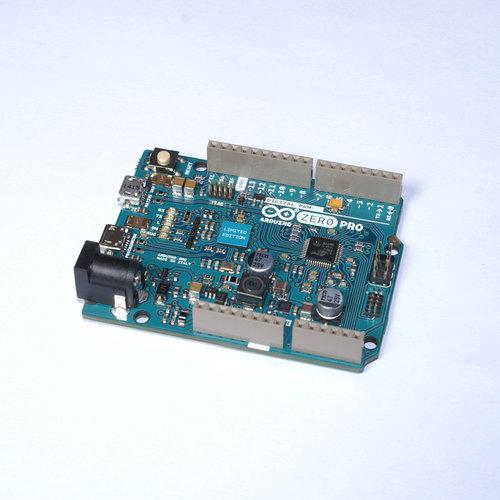Recently added
More...Categories
Suppliers
Newsletter
Once, twice in month we will send You info about new products, products on sale and news from Arduino and DIY world.
Arduino Zero Pro

Arduino Zero Pro is first Arduino board You can debug programs runnning on it!
Arduino Zero Pro and debugger
Check our tutorial how to connect debugger (using only microUSB cable) to Arduino Zero Pro.
With the new Arduino Zero Pro board, the more creative individual will have the potential to create one’s most imaginative and new ideas for IoT devices, wearable technologies, high tech automation, wild robotics and other not yet thinkable adventures in the world of makers. The Arduino Zero Pro represents a simple, yet powerful, 32-bit extension of the Arduino UNO platform. The board is powered by Atmel’s SAMD21 MCU, featuring a 32-bit ARM Cortex® M0+ core. With the addition of the Zero board, the Arduino family becomes larger with a new member providing increased performance. The power of its Atmel’s core gives this board an upgraded flexibility and boosts the scope of projects one can think of and make; moreover, it makes the Zero Pro the ideal educational tool for learning about 32-bit application development. Atmel’s Embedded Debugger (EDBG), integrated in the board, provides a full debug interface with no need for additional hardware, making debugging much easier. EDBG additionally supports a virtual COM port for device programming and traditional Arduino boot loader functionality uses.
The Arduino Zero Pro can be powered via the micro USB connection or with an external power supply. The power source is selected automatically.
External (non-USB) power can come either from an AC-to-DC adapter (wall-wart) or battery. The adapter can be connected to the board by plugging a 2.1mm center-positive plug into the board’s power jack. Leads from a battery can be inserted in the Gnd and Vin pin headers of the POWER connector.
The Arduino Zero Pro has a number of facilities for communicating with a computer, with another Arduino or other microcontrollers, and with different devices like phones, tablets, cameras and so on. The SAMD21 provides one hardware UART and three hardware USARTs for TTL (3.3V) serial communication.
The Programming port is connected to EDBG, which provides a virtual COM port to software on a connected computer (To recognize the device, Windows machines will need a .inf file, but OSX and Linux machines will recognize the board as a COM port automatically.). The EDBG is also connected to the SAMD21 hardware UART. The Serial on pins RX0 and TX0 provides Serial-to-USB communication for programming the board through the ATSAMD21G18 microcontroller. The Arduino software includes a serial monitor allowing simple textual data to be sent to and from the board. The RX and TX LEDs on the board will flash when data is being transmitted via the ATSAMD21G18 chip and USB connection to the computer (but not for serial communication on pins 0 and 1).
The Native USB port is connected to the SAMD21. It allows for serial (CDC) communication over USB. This provides a serial connection to the Serial Monitor or other applications on your computer. It also enables the Due to emulate a USB mouse or keyboard to an attached computer.
The Native USB port can also act as a USB host for connected peripherals such as mice, keyboards, and smartphones.
The SAMD21 also supports TWI and SPI communication. The Arduino software includes a Wire library to simplify use of the TWI bus. For SPI communication, use the SPI library.
Specification:
- Microcontroller: ATSAMD21G18
- Operating Voltage: 3.3V
- Digital I/O Pins: 14, with 12 PWM and UART
- Analog Input Pins: 6, 12-bit ADC channels
- Analog Output Pins: 1, 10-bit DAC
- DC Current per I/O Pin: 7mA
- Flash Memory: 256kB
- SRAM: 32kB
- EEPROM: up to 16kB by emulation
- Clock Speed: 48MHz
- Dimensions: 53mm x 70mm x 14mm
- Weight: 224g
Recently added
More...Categories
Suppliers
Newsletter
Once, twice in month we will send You info about new products, products on sale and news from Arduino and DIY world.













